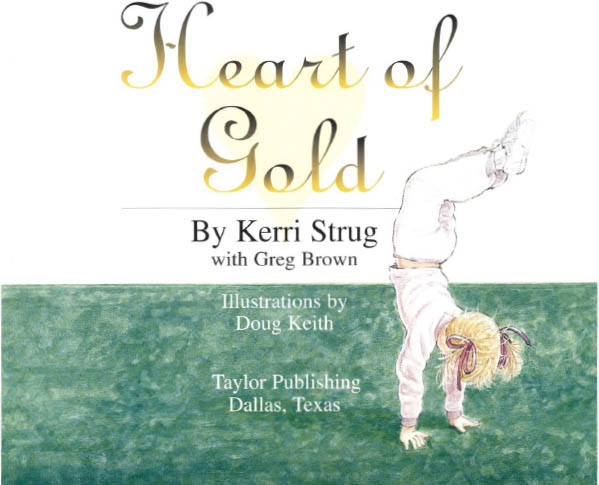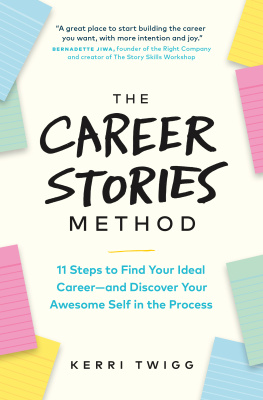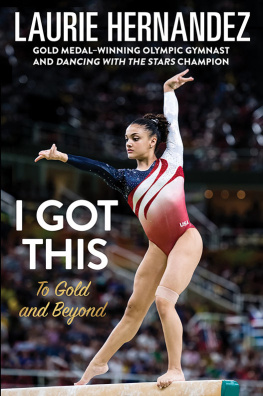

Greg Brown has been involved in sports for 30 years as an athlete and award-winning sports-writer. Brown started his Positively For Kids series after being unable to find sports books for his own children that taught life lessons. He is the coauthor of Sheryl Swoopes: Bounce Back; Mo Vaughn: Follow Your Dreams; Steve Young: Forever Young, Bonnie Blair: A Winning Edge; Cal Ripken: Count Me In; Troy Aikman: Things Change; Kirby Puckett: Be the Best You Can Be and Edgar Martinez: Patience Pays. Brown regularly speaks at schools and can be reached at: . He lives in Bothell, Washington, with his wife, Stacy, and two children.

Doug Keith provided the illustrations for the best-selling childrens book Things Change with Troy Aikman, Count Me In with Cal Ripken Jr., and Forever Young with Steve Young. His illustrations have appeared in national magazines such as Sports Illustrated for Kids, greeting cards, and books. Keith can be reached at his Internet address: .
Kerri Strug would like to give a special thankyou to her family for the constant love and support they have always provided. Additionally, she would like to thank her attorney Leigh Steinberg, for his guidance and invaluable counsel and Stefani Wanicur for her special attention. Without their contributions, this book would not have been possible.
Kerri has made a personal contribution to Special Olympics International, in support of its gymnastics programs for athletes with mental retardation, from the royalties received from the publication of this book.
To visit Kerri on America Online, use the Keyword Athlete Direct for access to Kerris AOL area. To visit Kerri on the Internet, go to www.strug.com .
All photos courtesy of the Strug family unless otherwise noted.
Copyright 1996 by Kerri Strug and Greg Brown All rights reserved.
No part of this book may be reproduced in any form or by any means without written permission from the publisher.
Published by Taylor Publishing Company
1550 West Mockingbird Lane
Dallas, Texas 75235
Designed by David Timmons
Library of Congress Cataloging-in-Publication Data
Strug, Kerri, 1977
Heart of gold / by Kerri Strug with Greg Brown; [illustrated by Doug Keith].
p. cm.
Summary: The young woman who helped the U.S. womens gymnastics team win a gold medal at the 1996 Olympics in Atlanta describes her lifelong interest in the sport and the lessons it has taught her.
ISBN: 978-0-87833-976-1
1. Strug, Kerri, 1977 Juvenile literature. 2. Women gymnastsUnited StatesBiographyJuvenile literature. 3. Olympic Games (26th : 1996 : Atlanta, Ga.)Juvenile literature.
[1. Strug. Kerri, 1977 .2. Gymnasts. 2. WomenBiography. 4. Youths writings.] I. Brown. Greg. II. Keith, Doug. ill. III. Title. GV460.2.S77A3 1996
796.44092dc20
[B]
96-45070
CIP
Printed in the United States of America
10 9 8 7 6 5 4 3 2 1

Kerri waving: Sarah Prall/Arizona Daily Star
My name is Kerri Strug, and Ive dedicated 14 years of my young life to gymnastics.
The demanding sport has given me lots of wonderful memories along with a few disappointments.
Ive written this book to share my story with you so you can learn from what Ive experienced and, hopefully, be inspired by my victories.

Few people knew my name before the 1996 Summer Olympics in Atlanta, even though I competed at the elite level for five years and helped the USA earn a bronze medal at the 1992 Barcelona Olympics.
I entered the Atlanta Centennial Games not knowing what to expect. Shannon Miller and Dominique Dawes were the well-known veterans and Dominique Moceanu was the rising young star. Some dubbed me the stepsister to the stars because it seemed my career had been overshadowed by others.
Of the seven members on our 1996 American team, only Amy Chow and I were true amateurs. You can only retain amateur status by never accepting money for competitions, showcases, or commercial endorsements.
I never took the money because only amateurs are allowed to compete in college and I planned to compete at UCLA as a college gymnast.
Despite my successes leading up to the games, I had a reputation for not performing at my best under pressure.
Several people involved with gymnastics would criticize me because my nervousness sometimes hindered my performance.
Others questioned my mental toughness and ability to handle pain. My coach, Bela Karolyi, used to tease me by calling me the baby.
One vault in Atlanta changed everything.
Millions watched on television the evening of July 23, 1996, when we entered our final team event. Team USA owned a comfortable lead. Only the vault, a springboard leap over a padded metal horse, stood between us and history. The American women had never won Olympic gold in team gymnastics.
After Moceanu unexpectedly fell twice on her vault, it was my turn. I was the last to jump and everyone believed victory rested on my shoulders.
But I fell on my first vault and heard a pop in my left ankle. A jolt of pain ran up my leg.
I had only seconds to decide what to do. Should I jump again to try and help the team win gold or stop and save myself for the individual competition days later?
I did what my heart told me was right. To fully understand what I felt, let me tell you about events that led to that memorable moment.

Mike Powell/Allsport

When I was born in Tucson, Arizona, in 1977, gymnastics had been part of our family for years. My older brother, Kevin, and older sister, Lisa, were gymnasts long before me.
I always looked up to my brother and sister, especially Lisa. We had a special bond. I liked everything she likedclothes, food, music, you name it.
I remember going to Kevin and Lisas gymnastics meets as a toddler and sitting motionless in the stands for hours. Id intently watch each routine and, as I grew older, Id keep score on my own.


Mom loved ballet and secretly hoped Lisa and I would love it, too. I took dance lessons when I was four years old. But by then, gymnastics was already my favorite.
My parents, Burt and Melanie, had the wisdom to let us try different things and then found the courage to allow us to follow our own interests.
Next page















